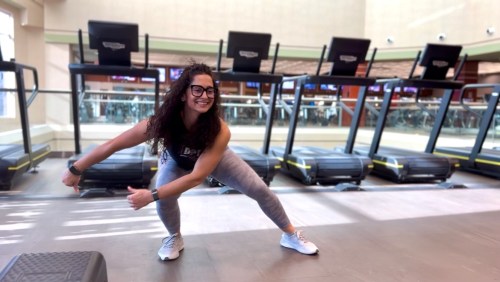Humans evolved to walk on two legs millions of years ago. But before we became bipedal, we moved more like our apelike ancestors—on four limbs. While most of us don’t spend a ton of time on all fours, it might be just what we need to build total-body strength and better mobility. Enter the lateral gorilla walk exercise.
Experts in This Article
certified personal trainer
This exercise, named for the way it imitates an ape’s gait, engages practically every major muscle group, including your shoulders and your core, and stretches areas of your body that tend to be tight (hello, hips and wrists).
Because the gorilla walk involves moving in multiple planes of motion at the same time, it’s super challenging for us two-legged creatures who don’t typically move in this way, says Sarah Pope, a personal trainer at Life Time Westchester. Read: it totally tests our strength, balance, and coordination.
Ready to get your gorilla walk on? Sure, you might feel a little silly at first, but that’s part of the fun.
- How often should you do the gorilla walk for the best results? You can do the exercise every day as long as it feels good. It works well as a warmup or dynamic stretch routine prior to a strength session since it gets your blood flowing and primes your muscles and joints, Pope says. On its own, the lateral gorilla walk even makes the perfect active recovery day workout, she adds.
- Who should try the lateral gorilla walk? Anyone who’s looking to level up their balance, mobility, and flexibility. The lateral gorilla walk, like other “animal flow” movement patterns, can increase your overall health and fitness, Pope says. This functional movement is also ideal if you’re training for an obstacle course race (OCR) like Spartan or Tough Mudder, Pope says. OCRs require you to move your body in different ways (think: crawling under a cargo net, climbing a wall, or swinging from monkey rings). “[The gorilla walk] forces the body to learn, adapt, and challenge our normal behaviors, while having fun,” Pope says.
- Who should stick to walking upright? The gorilla walk exercise isn’t for everyone. “I would not program this movement for someone if they have restrictive injuries in the ankle, knee, and/or hip,” Pope says. “Or if they could not properly sit down in a low squat position, pain free.” If you fall into any of these categories, don’t attempt the exercise. If you can’t perform the movement properly, you can end up hurting yourself (or exacerbating a previous injury).
How to do the gorilla walk exercise

- 1.Start in a low squat position with your feet slightly wider than shoulder-width apart.
- 2.Create fists with your hands and plant them on the ground in front of you. Try to maintain a neutral spine and upright posture (i.e., don’t slouch).
- 3.Gently sway from side to side and swing your hands to the left, planting your fists on the floor in front of you. Then jump your feet over, following your hands.
- 4.Try to build a steady momentum and continue moving in the same direction. Then reverse the move to travel in the opposite direction.
Benefits of the lateral gorilla walk
No matter what your training goals or skill level, gorilla walks can level up your fitness. Here are just a few reasons to add it to your regular workout routine.
Develops hip mobility
Most of us spend our days sitting, a lot. And when we do move, we usually stick to forward and backward motions. But this limited movement does a number on our hips. Our hip flexors often grow shorter, tighter, and stiffer as a result.
Turns out, walking like a gorilla is great for hip mobility and range of motion. The lateral gorilla walk works wonders for tight hips because it moves and stretches them through multiple planes of motion, Pope says. Not just the sagittal plane (forward and backward), but also the frontal plane (side to side) and transverse plane (rotational).
Increases balance and coordination
Shifting weight from your arms to your legs while simultaneously moving laterally tests your balance and stability. So does working in multiple planes of motion, Pope says.
The exercise also requires a ton of coordination (and a considerable amount of control over your muscles and joints) because you must synchronize your upper and lower limbs.
You might also notice that you’re steadier and/or more coordinated on one side of your body than the other. That’s super common. The more you practice, the more your “weaker” side will catch up.
Works your core
While it doesn’t look like your typical ab exercise, the lateral gorilla walk is a total core crusher. Whenever a movement requires balance, like this one does, your core muscles must work overtime to stabilize you (essentially so you don’t topple over), Pope says.
On top of this, any time you do a lateral motion, it recruits and fires up the side muscles in your abdominal area, also known as the obliques.
Strengthens your shoulders
Walking on all fours gives gorillas serious shoulder strength. Doing this exercise will do the same for you. Between the weight-bearing on your fists and the force of gravity pulling down on you, your shoulders have to, well, shoulder a lot weight, Pope says. Don’t be surprised if your upper body feels fatigued pretty quickly.
Improves wrist flexibility
Our wrists often become weak and stiff thanks to repetitive motions like typing all day or gripping a steering wheel. The lateral gorilla walk is like an antidote to tight wrists.
During the exercise, your wrists move through multiple planes of motion, Pope says. This stretches them in new ways, increasing their flexibility and range of motion.
Ramps up your heart rate
Did we mention gorilla walks get your heart pumping? While they appear deceptively easy, you need serious strength to shift all your bodyweight between your upper and lower body. This takes a lot of exertion. Plan on sweating and sucking wind.
Reveals muscle imbalances and weaknesses
Think of the gorilla walk exercise like a diagnostic tool. It tends to highlight and identify muscular tension, tightness, and weakness.
Where you struggle most in the movement pattern—whether with hip mobility, core strength, endurance, or flexibility—can tell you a lot about which body parts or areas of fitness need work.
“I personally would use this exercise as a warmup movement with my clients to really pinpoint imbalances in their body,” Pope says.
Once you know what imbalances and weaknesses you have, the best way to address them is by working with a personal trainer. They can design a safe training program to target your specific fitness needs and goals.
How to modify the gorilla walk exercise
“This movement is an advanced exercise,” Pope says. It can be really challenging depending on your current fitness level and limitations.
Still, don’t be discouraged if you haven’t gotten the swing of it yet (pun intended). You can always work up to it. The best way to modify the movement is “by simply breaking down the different body positions,” Pope says.
First, you want to “get comfortable with sitting in a deep low squat,” Pope says. Try practicing deep squats, keeping your feet flat to the ground and maintaining an upright posture.
“Once you are comfortable with sitting low to the ground, now you can work on body weight transfer through your core and ankles,” Pope says. In your deep squat position, start adding a little movement by rocking back and forth, shifting your weight from one foot to another. It might feel a little awkward at first, but in time, you’ll begin to create stability in the movement.
Then, break down the next phase of the movement into two parts, Pope says. First, practice swinging your arms across your body and planting your fists on the floor. Then, once you get the hang of that, try shifting your weight onto your fists as you jump your feet over.
With practice, you’ll build strength, mobility, and endurance and be able to swing your body like an ape in no time.
Sign Up for Our Daily Newsletter
Get all the latest in wellness, trends, food, fitness, beauty, and more delivered right to your inbox.
Got it, you've been added to our email list.











